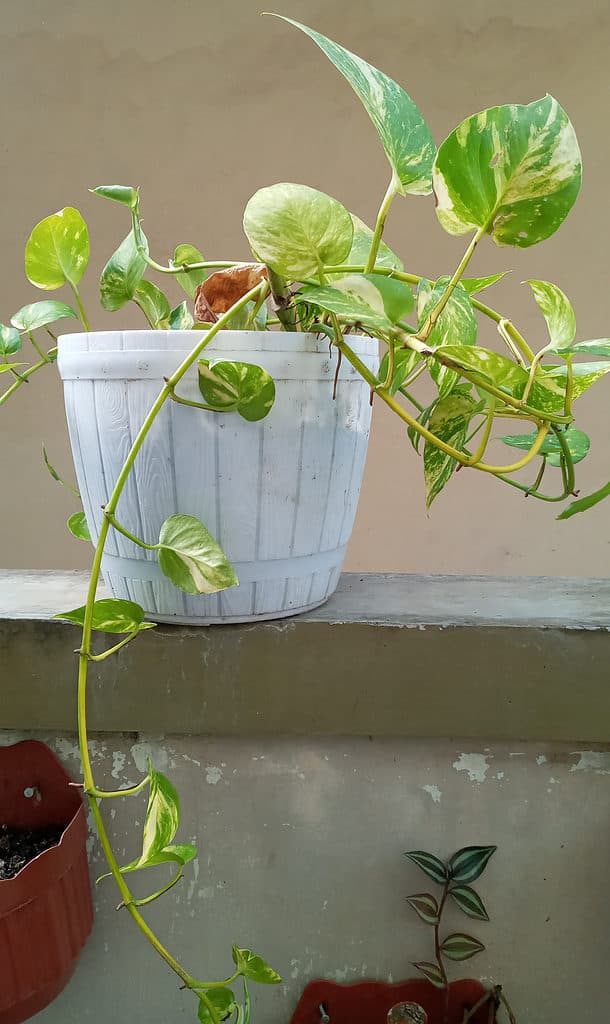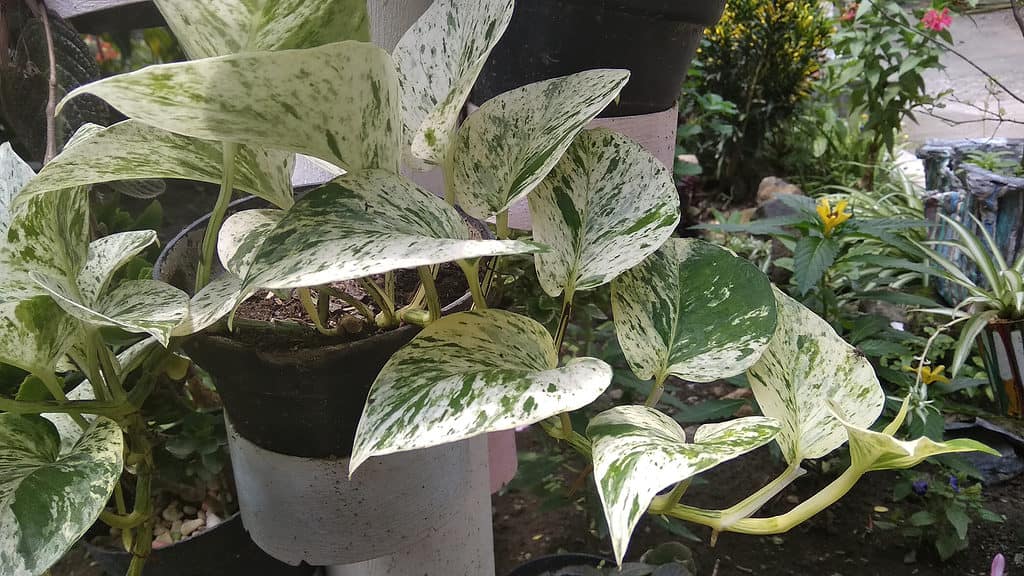Who doesn’t love a good pothos? Virtually un-killable and nothing if not beautiful, the pothos species Epipremnum aureum has become a hit in the last couple of decades among plant collectors and houseplant aficionados. And it certainly makes sense why! These are some really stunning plants that are almost impossible to kill.
With this plant’s popularity has come the demand for more varieties, leaf patterns, and overall color schemes. The Jessenia pothos and marble queen pothos are two absolutely stunning varieties of the original golden pothos plant that deliver aesthetic appeal in each plant’s own individual right. But how can one tell the difference between them? Believe it or not, the Jessenia pothos is believed to be a derivative cultivar of the marble queen pothos. Despite being parent and child, these two plants actually have quite a few differences between them in terms of how they look.
In this guide, we’ll explore everything aspiring pothos owners need to know about the Jessenia pothos and the marble queen pothos, as well as some important differences between the two.
Comparing Jessenia Pothos vs. Marble Queen Pothos
| Jessenia Pothos | Marble Queen Pothos | |
|---|---|---|
| Classification | Epipremnum aureum ‘Jessenia’ | Epipremnum aureum ‘Marble Queen’ |
| Alternative Names | N/A | N/A |
| Origin | South Pacific Islands, Asia | South Pacific Islands, Asia |
| Description | A cultivar of the golden pothos that boasts light golden variegation. | A cultivar of the golden pothos developed with stark cream and white variegation due to a gene mutation. |
| Uses | Houseplants | Houseplants |
| Growth Tips | Always plant this pothos in well-draining soil that is rich in nutrients. | Keep your marble queen pothos near a window with bright, indirect light to ensure it keeps its coloration and patterns. |
| Interesting Features | This variety is known for having very delicate golden-hued variegation on its bright green leaves. | This variety of pothos is incredibly popular among variegation pothos plants due to its unique look. |
The Key Differences Between Jessenia Pothos and Marble Queen Pothos
The Jessenia pothos and marble queen pothos are very similar. However, when placed together, their differences are pretty easy to pinpoint.
The variegation that the marble queen pothos boasts is a much lighter tone than that of the Jessenia pothos. Jessenia pothos tend to have golden, yellow, or gold-green variegation against mid-green leaves. The marble queen tends to have creamy white or pale yellow variegation against dark or mid-green leaves. The variegation of the marble queen is also much more intense than that of the Jessenia pothos. When you look at a marble queen pothos, their patterns tend to take up almost all of the leaf’s surface. Jessenia pothos’ variegation is a bit milder, though it is worth noting that some plants can have more variegation than others. No two leaves on either of these plants will look exactly the same.
Just as well, the Jessenia pothos is a bit of a slow grower compared to the marble queen pothos. The shape of the Jessenia pothos’ leaves also tend to be a bit narrower than that of the marble queen pothos.
With these above key differences in mind, the Jessenia pothos and marble queen pothos are still the same species of plant and thus have the same light, water, soil, and overall growing requirements.

The Jessenia pothos (pictured) has pale yellow or light-green variegation on its leaves.
©iStock.com/Bayu SRI TANJUNG
Jessenia Pothos vs. Marble Queen Pothos: Classification
The Jessenia pothos is classified in the plant trade as Epipremnum aureum ‘Jessenia’. Epipremnum aureum ‘Marble Queen’ is the classification of the marble queen. These two varieties are of the same species, but were both genetically altered and bred to have their variegation and unique patterns through human intervention. As such, neither variety can be found in the wild.
Jessenia Pothos vs. Marble Queen Pothos: Description
The Jessenia pothos is a somewhat newer variety in the plant market. With its tropical appearance and trailing tendrils, it looks fantastic almost everywhere both indoors and outdoors. The Jessenia pothos is known for its long trailing vines, heart-shaped waxy leaves, and green foliage with light green or yellow-gold variegation. The Jessenia pothos has been confused with the marble queen pothos in the past, yet the marble queen is substantially lighter and has finer cream-colored streaks or marbling all over its leaves. This cultivar can reach lengths of up to 30 feet in USDA hardiness zones 10 through 12. When growing indoors, it rarely reaches more than 10 feet long and will not grow flowers.
The marble queen pothos is a popular cultivar of variegation pothos that is quite easy to find at local garden centers. It has stunning heart-shaped leaves with green and white variegation and long, cascading tendrils. From a high shelf or planter, it works well as a lovely trailing or hanging plant. Compared to other pothos cultivars, the marble queen pothos grows rather quickly. Because of its marbled leaves’ ability to complement almost any interior and ease of maintenance under numerous growing conditions, this variety makes for one of the best houseplants for beginner plant parents. This variety requires indirect, intense sunshine to retain its marbled look because it has white variegation that lacks chlorophyll.

The marble queen pothos (pictured) has white variegation that varies from leaf to leaf and plant to plant.
©Rezqiano/Shutterstock.com
Jessenia Pothos vs. Marble Queen Pothos: Uses
Both of these pothos varieties are exclusively used for ornamental purposes as houseplants. They can also be grown outdoors in gardens, but they are not cold hardy and must be grown in very specific hardiness zones.
Jessenia Pothos vs. Marble Queen Pothos: Origin
All pothos are native to the South Pacific Islands and coastal regions of Asia. They have since been naturalized in tropical forests around they world. They are also considered invasive in many of the places where they have been introduced, including Australia and Puerto Rico.
The Jessenia pothos was likely developed by a specific breeder sometime in 2014. The only reliable information on the history of this cultivar states that Costa Farms patented and released the Jessenia variety to the plant trade in 2014. This plant is thought to actually be a cultivar of the marble queen pothos as well.
The origins of the marble queen pothos are a little bit muddy. Some sources will say they are a natural mutation that can be found in the wild, while others will say it is a patented cultivar. It is also believed that this cultivar was created way back in the 1950s. The actual origin of the variety is not abundantly clear, but the plant itself is widely available online and at local nurseries and garden centers.
Jessenia Pothos vs. Marble Queen Pothos: How to Grow
The planting and maintenance requirements for both the Jessenia pothos and marble queen pothos are the same.
Choose a container that fits your plants’ needs in terms of size. Make sure the container has space for the roots of the plants you intend to grow. While selecting the ideal pot, keep in mind that drainage is also crucial. If the pot you’ve picked lacks a drainage hole, you can fill the bottom of the pot with stones or clay pellets. Your plant will grow bigger in a larger container. We recommend keeping the pot on the smaller side since pothos prefer to have their roots constrained a little bit.
The key to thriving indoor plants is placing the proper plant in the appropriate location. Bright, indirect sunshine is ideal for marble queen pothos. In order to keep their varying colors, Jessenia pothos also require strong, indirect light. These plants can also thrive in lower light levels, but if the light is too low, the white or gold tint in the leaves can disappear and turn green. Prevent keeping your pothos in direct, harsh sunlight, since doing so might burn the foliage.
The soil should be kept on the drier side for pothos. Water well, then wait until the top half of the soil has dried before adding more water. Usually, pothos only need to be watered once or twice a week. Let the soil completely dry between waterings in the winter when the plant is dormant. While your marble queen or Jessenia pothos can technically endure low humidity, they will unquestionably flourish if you give them a surrounding humidity level of at least 40%. In general, 50% is the sweet spot for pothos humidity. Pothos are tropical plants that prefer more moisture in the air for their leaves but still require drier soil.
Both of these pothos varieties enjoy temperatures between 60 and 85 degrees F. These pothos cultivars have to be protected from temperatures below 60 degrees F, as they are not cold-hardy. Brown stains on leaves can emerge permanently as a result of prolonged exposure to cold temperatures.
A typical issue that manifests as yellowing of the leaves for pothos is overwatering. Pothos also dislike having damp feet, which can cause root rot. Plants that have been properly fed and cared for will be more resistant to typical issues like temperature changes, pests, and diseases. Trim the vines to keep your pothos looking healthy and bushy. Even better, you can start new plants from the stems you just removed and replant them in the same container to make your pothos appear bigger or denser.
Jessenia Pothos vs. Marble Queen Pothos: Special Features
The marble queen pothos is renowned for its unique beauty and almost completely white leaves. However, the variegation of this variety can also pose a problem. The white parts of the plant’s leaves are void of chlorophyll. Because of this, the green parts of the leaves have to work twice as hard to keep the plant alive and growing. Because of this, the marble queen pothos is definitely not suited for low-light growing situations, as it will simply revert back into a fully green plant to keep itself alive.
The Jessenia pothos is a popular selection among plant collectors due to the color of its variegation. Most variegated pothos, like the marble queen, have white or eggshell-colored variegation. The Jessenia is rare in that its variegation is gold or light green, making it a real collector’s item.
The marble queen pothos has been a major player in creating other variegated pothos cultivars. The Jessenia pothos, snow queen pothos, and the ultra-rare harlequin pothos are all believed to have been derived from the marble queen pothos’ unique natural genetic mutation that causes its variegation.
Both the Jessenia pothos and marble queen pothos are similar and excellent plants to keep as indoor houseplants. As long as you can provide these varieties with enough sunlight to help them keep up their unique variegation, both of these plants would make an excellent addition to any indoor plant collection.
Want to learn more about the eye-catching pothos houseplant? Check out our in-depth guide to everything you need to know about pothos!
The photo featured at the top of this post is ©
FAQs (Frequently Asked Questions)
What is the difference between Jessenia pothos and marble queen pothos?
While extremely similar, the variegation on the marble queen pothos is whiter than the variegation on the Jessenia pothos.
Are marble queen pothos plants hard to care for?
Not at all. This variety does very well in low light and can handle occasional neglect.
Should my marble queen pothos be misted?
Misting is a great way to boost humidity around your pothos, but try not to overdo it.
Thank you for reading! Have some feedback for us? Contact the AZ Animals editorial team.






